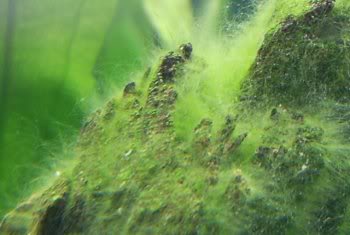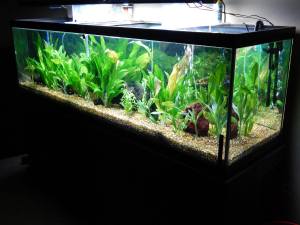The most carefully tended tropical aquarium can still fall prey to algae, which can quickly overwhelm the tank. Left unchecked, algae saps vital nutrients from the water and can stop oxygen and light from reaching other plants and fish. In vast quantities it also ruins the appearance of the tank, covering the interior with a green or brown slime.

A little bit of algae can add character and authenticity to your aquarium. Yet as it is a natural, hardy plant it can appear almost overnight and take over your carefully managed aquarium. Swell UK have a range of treatments, aquarium filters and maintenance tools that can help you to avoid nuisance algae or even treat if necessary.
Common Types of Algae
Green Water – single algae cells can quickly gather and turn the water a murky green. This stops light and oxygen from penetrating the water, as well as looking very unsightly.
Brown Algae – this is most common in new aquariums. A brown film can form as sheets, but luckily it is very easy to remove. In most cases as the tank matures, this problem lessens.
Green Carpet Algae – this is probably the most common type. Fast spreading, this thick green variant covers rocks, glass and décor quickly.
Beard Algae – This is the toughest type, and therefore can be the hardest to remove. It looks like small bristles in a blue/green to black/green, and can be tough to eradicate if left to grow for too long.
Causes and Treatments
Algae needs three things to thrive; water, light and nutrients. Of course water is vital, but you can control the amount of light and nutrients to keep algae at bay and a cleaner tank.
Using a good aquarium filter with biological media to break down the phosphates and nitrates is a key way to filter out an excess of these elements. Good filtration overall is important as the removal of fish waste from the water lowers the amount of ammonia present and keeps the water cleaner.
An abundance of algae causing nutrients can also be caused by over feeding, which results in more fish waste. So only feed your fish as much as they can eat and remove any excess after a few minutes. A small net can be a handy tool, or consider the use of a feeding station to control the spread of the flakes or pellets.
Make sure that the tank is kept out direct sunlight, as this is a key cause. Also try to ensure that the artificial lights in your tank are only on for around 10-12 hours per day. A timer is a great way to monitor the amount of light, especially for those with busy schedules.

Some plants provide a great algae barrier too. They naturally use up phosphates in the water, lowering the risk of algae. You could also try adding an algae eater to the tank, certain types of snail shrimps and cat fish thrive on a diet of algae from the tank floor, rocks and décor, keeping the tank cleaner for longer.
Good maintenance is also key to keeping algae at bay. Regular 10-15% water changes keep the level of nutrients down. Scrub décor and other items well to remove traces of algae and scrape the build up from the sides of the tank.
With careful maintenance and a little research you can stop algae spreading before it really takes hold!


Related Posts
A Deeper Look In To Loach Fish Species
How Much Salt Should I Add To My Freshwater Aquarium
Everything You Need To Know About Using T5 Lights For Your Aquarium